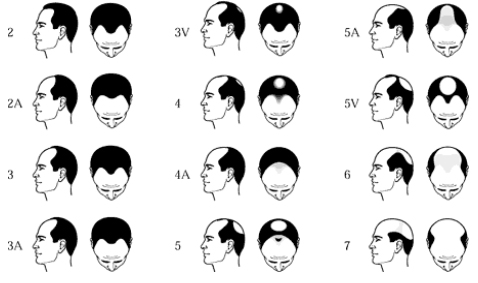 |
Androgenetic Alopecia Male pattern baldness (MPB), also known as androgenetic alopecia (AGA), is the most common cause of hair loss that can affect up to 70% of men at some point in their lifetime. Typically MPB follows a pattern that begins with the hairline gradually moving backwards (recedes) and can form an “M” shape. The crown of the head can also exhibit progressive thinning and eventual baldness in some individuals. The Norwood Scale is often used as a guide to determine the severity of male pattern hair loss based on the most typical patterns: Related Problem(s): Excessive Hair Loss What happens in male pattern baldness?MPB is an inherited condition, where hair follicles in the affected regions of the scalp have a genetically determined sensitivity to the effects of a male hormone derivative or by-product called dihydrotestosterone (DHT). DHT is believed to shorten the growth phase of the hair cycle, causes the follicle to shrink (miniaturization) and produce progressively fewer and finer hairs. The production of the DHT hormone is controlled by an enzyme called 5-alpha reductase. Typically the hair follicles in the frontal through mid-scalp to the crown can be genetically sensitive to the effects of DHT, whilst most hair follicles at the back and sides of the scalp are resistant to such effects of DHT, therefore remain permanent even with extensive male pattern hair loss. Medical Therapy for Male Pattern Hair LossMedical therapies are useful in the prevention and treatment of male pattern hair loss, particularly in the early stages of the balding process. These medical therapies work to thicken hair in areas that are thinning (miniaturized hairs). There are currently two FDA-approved medications approved to treat androgenetic alopecia, namely finasteride and a minoxidil topical formulation (eg. Rogaine), and have to be continually used to exert and maintain its effects. Hair loss returns when you stop either of these medicines. Oral Finasteride (Proscar, Propecia)Finasteride works by specifically inhibiting an enzyme known as 5-alpha-reductase, which converts testosterone into a more potent androgen dihydrotestosterone (DHT). It is DHT that shrinks or “miniaturizes” the hair follicle, which eventually leads to baldness known as male pattern baldness or androgenetic alopecia. When finasteride is taken at a dose of 1mg daily, the DHT levels in the scalp are lowered by as much as 60%. This reduction in DHT has been proven to stop the progression of hair loss in 86% of men taking the drug during clinical trials. In addition 65% of trial participants had increased hair growth. The American Hair Loss Association recommends finasteride as the first line treatment for men interested in treating their male pattern baldness.Although side effects are generally uncommon, reduced libido or erectile dysfunction have been reported in less than 1 in 50 patients.Persistent erectile dysfunction has been reported to occur in some men who have taken finasteride. Make sure to discuss with your dermatologist about the pros and cons and potential side effects before you decide to start such treatment. Topical Minoxidil (eg. Rogaine)Minoxidil 5% in solution or foam can be directly applied to the affected scalp to help stimulate follicles where hairs are thinning and is thought to work through increasing the blood circulation to the applied area of the scalp. It is less effective than oral finasteride but can help to slow hair loss for many men, and some men grow new hairs. For those undergoing hair transplant, topical minoxidil is helpful for reducing “shock” loss. Side effects with topical minoxidil are generally uncommon, causing scalp irritation in individuals with a sensitive scalp. |
|
DISCLAIMER: The information contained in this site is strictly intended only for the use of registered patients and is confidential and may be privileged and/or otherwise protected from disclosure. Any unauthorised use, copying, dissemination or any other action taken or otherwise omitted to be taken in reliance upon this information is prohibited.


